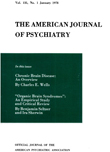Abstract
Twenty-eight cases of toxic psychosis during or following the therapeutic administration of atabrine are reported. Although the psychotic reactions occurred in less than 2 patients per 1000 treated with atabrine on this island, the number of mental reactions observed is believed the consequence of the heavy dosage frequently utilized in the treatment of malaria. Psychoses during treatment with 0.3 gm. daily for 7 days occurred rarely, for only 2 cases were seen, though large numbers of patient were treated in this manner. There appears to be a relationship between the frequency of psychotic reactions and the amount of atabrine and the rapidity with which it is given.
Two cases are reported in which the psychosis not only cleared after withdrawal of the drug, but recurred when atabrine was again given, and again cleared after cessation of therapy. Another case is cited of a subject who took the drug experimentally, never having had malaria, and became mildly psychotic. The 3 cases together indicate clearly that atabrine causes psychotic reactions, and that malarial fever and the release of malarial toxins need not be etiologic factors as has sometimes been hypothesized.
In most instances the psychosis appeared during, or immediately following, the course of treatment. In a few patients, who received very large amounts of atabrine over a short period of time, the onset was delayed and occurred a few days after the cessation of therapy.
Toxic psychoses are expected to clear after removal of the toxic agent. Eight of the 28 patients failed to recover adequately but only 2 were observed for more than a month after the onset of the psychosis. It is probable that 2 reactions represented schizophrenic psychoses which had been precipitated by the illness or the therapy, although the possibility of the production of permanent damage by large amounts of atabrine cannot be excluded.
The clinical pictures observed varied widely, and resembled acute excitements of a manic or schizophrenic nature, severe depressive reactions, and paranoid schizophrenia. The presence of confusion, and particularly a sudden onset, with confused behavior and clouded sensorium, in a patient who had received atabrine distinguished the reactions from non-toxic psychoses. Rapid recovery after cessation of therapy usually helped confirm the diagnosis.
The occurrence of psychotic reactions was found to be the major limitation to the amount of atabrine which can be given safely, because of these reactions and because of complaints of mild confusion and the occurrence of convulsive seizures in other patients, very heavy dosage was abandoned by one hospital, after which atabrine psychoses again became a rarity.
Awareness of the possibility of atabrine psychosis should lead the physician to appreciate the importance of early signs, such as feelings of confusion and of intoxication. Such awareness will permit more prompt withdrawal of the drug and, in some instances, might prevent a frank psychosis. Prompt diagnosis is essential to proper therapy, both in the immediate stoppage of atabrine and in the handling of the psychotic reaction.
Seven cases are reported in which the Patient suffered a generalized convulsion during or immediately following a course of atabrine administered orally for the treatment of tertian malaria. One patient had experienced a single convulsion 8 years before, and in one case the seizure may have been caused by hypoglycemia. In the remaining 5 cases no basis for the convulsion could be found in the patient's history or by the examinations which were carried out, other than the coincidence with atabrine therapy. It is known that atabrine, particularly in large doses, can be toxic to the human central nervous system as it produces psychoses; and animal experimentation and the reports of the intramuscular use of atabrine musonate have shown that toxicity can take the form of epileptiform seizures. It is therefore believed that the convulsions here reported were the result of atabrine toxicity. The occurrence of convulsions during atabrine therapy is extremely infrequent. Only one case is reported following conservative therapy, and despite the frequent usage of unusually large amounts of atabrine on the island, the 7 cases represent an incidence of far less than 1 case per 2000 malarial attacks treated with atabrine.

